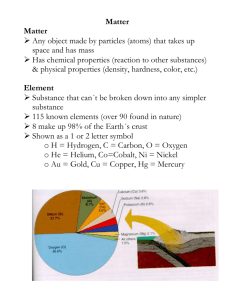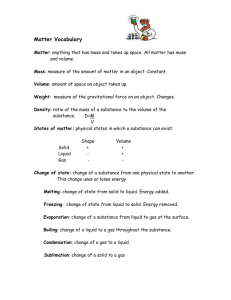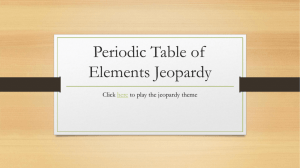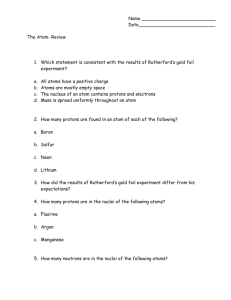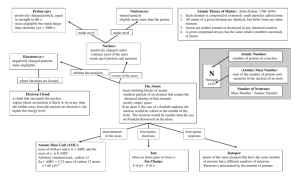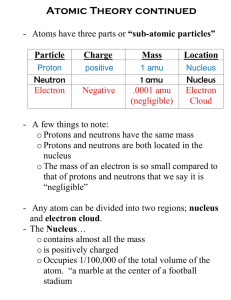Atomic Structure
advertisement
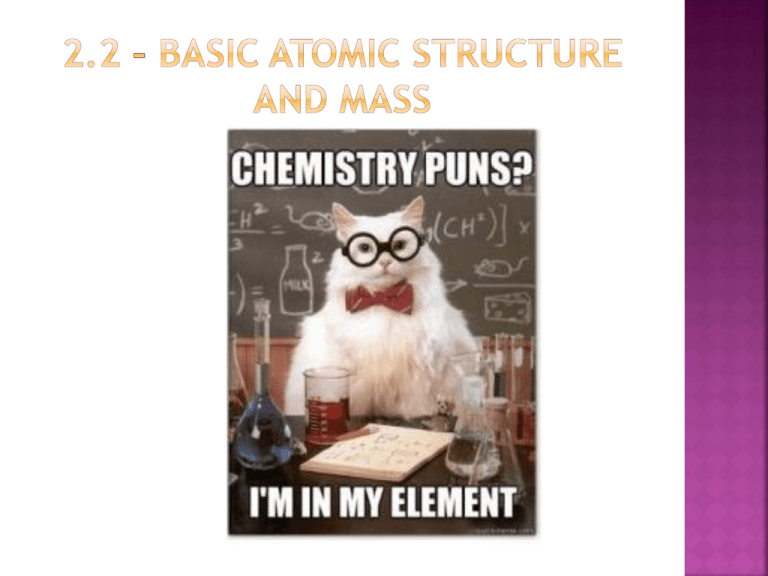
Atom The smallest particle of an element that still retains the chemical properties of that element. Atoms are composed of 3 sub-atomic particles: Protons Neutrons Electrons Electrons Electrons (Thomson proposed) possess negative electrical charges. Electrons are 1/1837th the mass of a single proton or single neutron. Electrons are found orbiting the nucleus of an atom, in what is referred to as the electron cloud. They move at the speed of light and “create” a cloud-like appearance. Electrons are not in set orbitals. Protons (Rutherford, Geiger, and Marsden proposed) Protons possess a positive electrical charge. Protons are found clumped together within the nucleus of an atom. Each proton has a mass of 1 AMU or 1 Dalton (Named after John Dalton.) Neutrons (Rutherford proposed) Neutrons possess no electrical charge and are therefore referred to as neutral. Neutrons are also found clumped together within the nucleus of an atom. Each neutron has a mass of 1 AMU or 1 Dalton. Nuclear Forces These are short-range proton to neutron OR proton to proton OR neutron to neutron attractive forces that help hold together the nucleus of an atom. These forces are greater than the repulsive same charge electrical forces exhibit by protons. Atomic Radii This term refers to the relative size of an individual atom of an element. It is measured from the center of the nucleus to the outermost electron cloud. It is measured in picometers (pm) A picometer is 1.0 x 10-12 meters (so it is very, very small) This term refers to the number of protons found within the nucleus of an atom for that element. Each element has a unique and identifying number of protons. The atomic number for each element led to the creation of the Periodic Table. The Periodic Table was created ordered upon increasing Atomic Number. Draw a carbon atom. Draw the electrons orbiting the nucleus (that is not really how it works). Element # of protons Atomic # (Z) 6 6 Phosphorus 15 15 Gold 79 79 Carbon The Periodic Table was originally created by Dmitri Mendeleev in 1869. He was a Russian Chemist. The atomic number is sometimes written as superscript (above) the Elements Chemical symbol. Some of the symbols use the Latin term, instead of the English word like Iron, its symbol is Fe for “Ferrum”. Latin is used because it is a “dead” language (will not change over time) and was the original language of science. Also Known as (A.K.A.) Mass Number This was based on Carbon-12 as the standard element of measure. It has 12.0 AMU. This term refers to the total weight of an atom of that element. It is found by adding the number of protons and neutrons together. Each proton OR each neutron has a mass of 1 AMU or 1 Dalton. Electrons mass is insignificant as they are so small (1/1837th that of protons/neutrons). Mass # = p+ + n0 18 Arsenic Phosphorus 8 75 16 8 18 33 75 15 31 This term refers to atoms of an element that have different masses (AMUs) because they have different numbers of neutrons within the atom; even though it is the same element because they have the same number of protons. Remember, protons identify the element. The isotopes behave relatively the same as the natural atom in terms of chemical properties. Some Isotopes are radioactive (the nucleus is “breaking apart”). How Isotopes are written chemically: Hyphen notation – symbol- number Example: Carbon-14 OR C-14. How Isotopes are written chemically: Nuclear notation – AMU over Atomic Number symbol, for example 146C. Nuclide – this term is used to refer to the nucleus only (no e- cloud) of an Isotope. Most elements have several isotopes present in nature, the mass of each isotope must be considered to find the average mass for an element (as seen on the Periodic Table). Example: Copper has two main isotopes Cu63 and Cu65. 69.15% Cu63 = 62.93 AMU 30.85% Cu65 = 64.93AMU How to calculate the average atomic Mass of an element: Step 1: Multiply the AMU for a single isotope by the % found in nature. Move the decimal point two places to the left and then multiply by the AMU. Cu63 = 62.93 x 69.15% (nature) = 62.93 x .6915 = 43.5161 AMU Cu65 = 64.93 x 30.85% (nature) = 64.93 x .3085 = 20.0309 AMU Step 2: Round to two places after the decimal for each isotope calculation in Step 1. Step 3: Add the all AMUs together. 43.52 + 20.03 = 63.55 AMU
